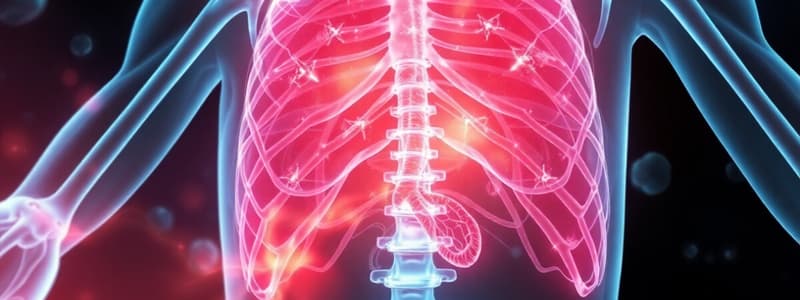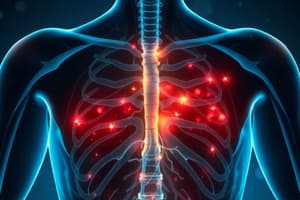Podcast
Questions and Answers
Which of the following features of hypercalcemia are NOT associated with underlying cancer?
Which of the following features of hypercalcemia are NOT associated with underlying cancer?
- Bone pain
- Neck mass
- Lymphadenopathy
- Polydipsia and polyuria (correct)
Which of the following conditions is NOT typically associated with hypercalcemia?
Which of the following conditions is NOT typically associated with hypercalcemia?
- Addison's disease (correct)
- End-stage CKD
- Thyrotoxicosis
- Familial hypocalciuric hypercalcemia (FHH)
Which of the following is a characteristic ECG change associated with hypercalcemia?
Which of the following is a characteristic ECG change associated with hypercalcemia?
- Prolonged QT interval
- Short QT interval (correct)
- ST segment depression
- Widened QRS complex
Which of the following is NOT a potential cause of primary hyperparathyroidism (PHPT)?
Which of the following is NOT a potential cause of primary hyperparathyroidism (PHPT)?
Which of the following symptoms of hypercalcemia is most likely to be present in patients with significant hypercalcemia?
Which of the following symptoms of hypercalcemia is most likely to be present in patients with significant hypercalcemia?
What is the primary mechanism by which osteoprotegerin (OPG) inhibits osteoclast activity?
What is the primary mechanism by which osteoprotegerin (OPG) inhibits osteoclast activity?
Which of the following is NOT a characteristic of familial hypocalciuric hypercalcemia (FHH)?
Which of the following is NOT a characteristic of familial hypocalciuric hypercalcemia (FHH)?
Which of these conditions is typically characterized by hypercalcemia, but is not associated with hyperparathyroidism?
Which of these conditions is typically characterized by hypercalcemia, but is not associated with hyperparathyroidism?
According to the table, which of the following features of hypercalcemia could suggest a possible diagnosis of cancer?
According to the table, which of the following features of hypercalcemia could suggest a possible diagnosis of cancer?
What is the most prevalent cause of hypercalcemia in an ambulatory population?
What is the most prevalent cause of hypercalcemia in an ambulatory population?
Which of the following conditions is directly associated with increased RANKL activation?
Which of the following conditions is directly associated with increased RANKL activation?
Which of the following genetic conditions may be associated with hyperparathyroidism?
Which of the following genetic conditions may be associated with hyperparathyroidism?
What is the key distinction between familial hypocalciuric hypercalcemia (FHH) and primary hyperparathyroidism (PHPT) from a biochemical standpoint?
What is the key distinction between familial hypocalciuric hypercalcemia (FHH) and primary hyperparathyroidism (PHPT) from a biochemical standpoint?
Which of the following best describes the mechanism of action of denosumab in the treatment of hypercalcemia?
Which of the following best describes the mechanism of action of denosumab in the treatment of hypercalcemia?
What role does vasopressin play in the regulation of calcium homeostasis?
What role does vasopressin play in the regulation of calcium homeostasis?
In what clinical setting is malignancy more likely to be the primary cause of hypercalcemia?
In what clinical setting is malignancy more likely to be the primary cause of hypercalcemia?
What is the primary approach to managing hypercalcemic crisis?
What is the primary approach to managing hypercalcemic crisis?
What percentage of hypercalcemic crisis cases are considered asymptomatic?
What percentage of hypercalcemic crisis cases are considered asymptomatic?
In what scenario should hypercalcemic crisis be considered in a patient?
In what scenario should hypercalcemic crisis be considered in a patient?
What is the primary focus of management for hypercalcemic crisis?
What is the primary focus of management for hypercalcemic crisis?
What is the role of calcimimetics in the management of hypercalcemic crisis?
What is the role of calcimimetics in the management of hypercalcemic crisis?
What is the importance of bisphosphonates in the management of hypercalcemic crisis?
What is the importance of bisphosphonates in the management of hypercalcemic crisis?
What is the role of RANKL system inhibitors in the management of hypercalcemic crisis?
What is the role of RANKL system inhibitors in the management of hypercalcemic crisis?
What is a defining feature of hypercalcemic crisis?
What is a defining feature of hypercalcemic crisis?
What is the therapeutic role of Cinacalcet in the management of hypercalcemia?
What is the therapeutic role of Cinacalcet in the management of hypercalcemia?
What concerning aspect does hypercalcemia associated with cancer present?
What concerning aspect does hypercalcemia associated with cancer present?
Which condition is associated with abnormal levels of parathyroid hormone and calcium in patients with hyperthyroidism?
Which condition is associated with abnormal levels of parathyroid hormone and calcium in patients with hyperthyroidism?
What is a common treatment option for patients with refractory hypercalcemia?
What is a common treatment option for patients with refractory hypercalcemia?
What is a significant challenge in managing hypercalcemia during pregnancy?
What is a significant challenge in managing hypercalcemia during pregnancy?
What is the primary mechanism by which bisphosphonates treat hypercalcemia?
What is the primary mechanism by which bisphosphonates treat hypercalcemia?
Which bisphosphonate is described as being 1000 times more potent than pamidronate?
Which bisphosphonate is described as being 1000 times more potent than pamidronate?
What is the recommended time frame for administering intravenous bisphosphonates after rehydration for severe hypercalcemia?
What is the recommended time frame for administering intravenous bisphosphonates after rehydration for severe hypercalcemia?
In which scenario would bisphosphonates be particularly avoided?
In which scenario would bisphosphonates be particularly avoided?
What is the typical duration of intravenous bisphosphonate treatment for severe hypercalcemia?
What is the typical duration of intravenous bisphosphonate treatment for severe hypercalcemia?
Which of the following medications is specifically mentioned as being useful in hypercalcemia involving cytokine release?
Which of the following medications is specifically mentioned as being useful in hypercalcemia involving cytokine release?
What is the recommended dose of pamidronate for severe hypercalcemia with a calcium level of 3 mg/dL?
What is the recommended dose of pamidronate for severe hypercalcemia with a calcium level of 3 mg/dL?
What is the key action of calcimimetics like cinacalcet in managing hypercalcemia?
What is the key action of calcimimetics like cinacalcet in managing hypercalcemia?
Which of the following is NOT a mechanism by which hypercalcemia can occur?
Which of the following is NOT a mechanism by which hypercalcemia can occur?
What is the role of the calcium-sensing receptor (CaSR) in maintaining calcium homeostasis?
What is the role of the calcium-sensing receptor (CaSR) in maintaining calcium homeostasis?
Which of the following is NOT a direct action of parathyroid hormone (PTH) in maintaining calcium homeostasis?
Which of the following is NOT a direct action of parathyroid hormone (PTH) in maintaining calcium homeostasis?
What is the role of the RANK/RANKL/OPG system in hypercalcemia?
What is the role of the RANK/RANKL/OPG system in hypercalcemia?
What is the primary cause of hypercalcemia in most cases?
What is the primary cause of hypercalcemia in most cases?
Why might a patient with renal failure exhibit hypocalciuria despite having hypercalcemia?
Why might a patient with renal failure exhibit hypocalciuria despite having hypercalcemia?
Which of these factors is NOT directly implicated in the development of hypercalciuria?
Which of these factors is NOT directly implicated in the development of hypercalciuria?
What is a potential consequence of prolonged hypercalcemia?
What is a potential consequence of prolonged hypercalcemia?
Flashcards
Calcium-sensing receptor (CaSR)
Calcium-sensing receptor (CaSR)
A receptor on parathyroid gland cells that detects ionized calcium levels.
PTH
PTH
Parathyroid Hormone; increases calcium in blood by promoting bone resorption and kidney absorption.
Hypercalcemia
Hypercalcemia
An elevated level of calcium in the blood, often due to various factors like bone resorption.
Bone resorption
Bone resorption
Signup and view all the flashcards
RANK/RANKL/OPG system
RANK/RANKL/OPG system
Signup and view all the flashcards
Calcium reabsorption
Calcium reabsorption
Signup and view all the flashcards
Hypercalciuria
Hypercalciuria
Signup and view all the flashcards
Nephrogenic DI
Nephrogenic DI
Signup and view all the flashcards
Vasopressin binding
Vasopressin binding
Signup and view all the flashcards
RANK and RANKL
RANK and RANKL
Signup and view all the flashcards
Osteoprotegerin (OPG)
Osteoprotegerin (OPG)
Signup and view all the flashcards
Primary Hyperparathyroidism (PHPT)
Primary Hyperparathyroidism (PHPT)
Signup and view all the flashcards
Familial Hypocalciuric Hypercalcemia (FHH)
Familial Hypocalciuric Hypercalcemia (FHH)
Signup and view all the flashcards
Denosumab
Denosumab
Signup and view all the flashcards
Vitamin D deficiency
Vitamin D deficiency
Signup and view all the flashcards
PHPT
PHPT
Signup and view all the flashcards
THPT
THPT
Signup and view all the flashcards
MEN
MEN
Signup and view all the flashcards
Symptoms of Hypercalcemia
Symptoms of Hypercalcemia
Signup and view all the flashcards
Underlying Causes of Hypercalcemia
Underlying Causes of Hypercalcemia
Signup and view all the flashcards
ECG Changes in Hypercalcemia
ECG Changes in Hypercalcemia
Signup and view all the flashcards
Medical management of hypercalcemia
Medical management of hypercalcemia
Signup and view all the flashcards
Cinacalcet
Cinacalcet
Signup and view all the flashcards
Hydration in management
Hydration in management
Signup and view all the flashcards
Role of bisphosphonates
Role of bisphosphonates
Signup and view all the flashcards
Calcimimetics
Calcimimetics
Signup and view all the flashcards
RANKL system
RANKL system
Signup and view all the flashcards
Acute hypercalcemia management
Acute hypercalcemia management
Signup and view all the flashcards
1,25-dihydroxyvitamin D3
1,25-dihydroxyvitamin D3
Signup and view all the flashcards
Hypercalcemia with Cancer
Hypercalcemia with Cancer
Signup and view all the flashcards
Denosumab in Parathyroid Carcinoma
Denosumab in Parathyroid Carcinoma
Signup and view all the flashcards
Management of Thyrotoxicosis
Management of Thyrotoxicosis
Signup and view all the flashcards
Bisphosphonates
Bisphosphonates
Signup and view all the flashcards
Zoledronate
Zoledronate
Signup and view all the flashcards
Pamidronate
Pamidronate
Signup and view all the flashcards
Calcium mobilization
Calcium mobilization
Signup and view all the flashcards
Postoperative hypocalcemia
Postoperative hypocalcemia
Signup and view all the flashcards
Hydration prior to bisphosphonates
Hydration prior to bisphosphonates
Signup and view all the flashcards
Study Notes
Hypercalcemia
- Approximately 99% of total body calcium is stored in bone
- Physiologically important calcium is free (ionized) and tightly regulated
- Calcium homeostasis is regulated by vitamin D metabolites and parathyroid hormone (PTH) via the kidney, intestine, and bone
- PTH is secreted by the parathyroid glands' chief cells, and reacts rapidly to changes in serum ionized calcium through the extracellular calcium-sensing receptor (CaSR)
- Hypercalcemia is diagnosed with serum calcium >10.5mg/dL (2.6 mmol/L) on at least two occasions.
- Adjusted calcium >12 mg/dL (3.0 mmol/L) can cause nephrogenic diabetes insipidus and other serious complications
- Measurement of intact PTH levels is central to calcium disorder diagnosis. Increased or inappropriately normal PTH levels are associated with some hypercalcemia causes. PHPT (primary hyperparathyroidism) accounts for most cases in an ambulatory population
- Malignancy is the most common cause of inpatient hypercalcemic crises (HCM). This complicates 5-30% of malignancies and is responsible for >50% crises.
- Increased bone resorption from activation of osteoclasts via RANK/RANKL pathway is a common final pathway of severe hypercalcemia.
- Acute hypercalcemia is managed with fluid resuscitation to correct volume state and short-term calcitonin. Long-term management with bisphosphonates and/or denosumab is needed.
- Glucocorticoids may be used for hypercalcemia related to vitamin D overdose, granulomatous diseases and some malignancies
Hypercalcemia Introduction
- The skeleton, a major calcium reservoir, is important for locomotion, protecting vital organs, hematopoiesis, and regulating metabolic processes.
- Continuous bone remodeling involves osteoclasts and osteoblasts, maintaining bone integrity.
- Calcium homeostasis, maintained by the parathyroid hormone, vitamin D metabolites and the kidney, is critical.
Calcium Pathophysiology
- Calcium absorption from the intestine, filtration in the glomeruli, reabsorption in renal tubules, and elimination in urine are key components of calcium homeostasis.
- Calcium exists in three forms in plasma: 50% free (ionized), 40% bound to plasma proteins and 10% complexed with small diffusible inorganic ions.
- Primary hyperparathyroidism (PHPT) (caused by parathyroid tumors) and malignancy account for the majority of detected hypercalcemia cases.
- Other factors like vitamin D, and calcium/vitamin D supplementation contribute to hypercalcemia.
Studying That Suits You
Use AI to generate personalized quizzes and flashcards to suit your learning preferences.




